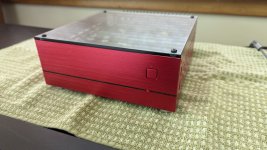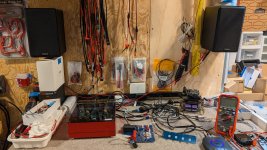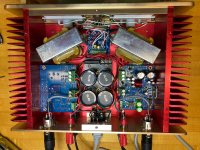That's a really good question. I don't know the answer to that. I have built both and measured both. They both measure good, but if I measure any difference is it because of part-to-part variation or due to the different package options? I'd have to build a statistically significant number of them to say.What is the difference between opa627 that are in to-99 metal can and dip-8 plastic? Is one better then the other? measurements? sound?
That said, the metal can version fetches ~2.5x what the DIP does on the grey market, so there is that. Also, the TO-99 is the IC package that offers the lowest stress on the IC die. I know that can translate to lower DC offset, but I don't know if it can also impact things like distortion.
I'll keep the two boards that I built with the TO-99 for myself. I'll sell the DIP versions. But that's me.
Tom
I'm not sure where is better to ask this so I'll try here!
Many moons ago I was at an audio 'bake off' where many pieces of gear were trialled. This is in the UK.
We went thought some massively expensive stuff and eventually chap called Simon from Sheffield got his big monoblocks out. I believe he is on here. Turns out they were an older iteration of your design's Tom. I think referred to as mod86 or parallel86 as there were 2 boards in each monoblocks. Using the now obsolete LM4780(?) amp chip.
Maybe there was some synergy on that day but to my ears they bested anything else I heard in that room. What then really piqued my interest was learning that they were a 'diy' build. I wasn't there with a fat cheque book!
Seems to have taken me some time but my interest is rekindled for one of these chip amps.
Long story short.....what would be the closest match for that amp I heard back then.? Are the 3886 sonically very similar to the 4870?
Thanks
Many moons ago I was at an audio 'bake off' where many pieces of gear were trialled. This is in the UK.
We went thought some massively expensive stuff and eventually chap called Simon from Sheffield got his big monoblocks out. I believe he is on here. Turns out they were an older iteration of your design's Tom. I think referred to as mod86 or parallel86 as there were 2 boards in each monoblocks. Using the now obsolete LM4780(?) amp chip.
Maybe there was some synergy on that day but to my ears they bested anything else I heard in that room. What then really piqued my interest was learning that they were a 'diy' build. I wasn't there with a fat cheque book!
Seems to have taken me some time but my interest is rekindled for one of these chip amps.
Long story short.....what would be the closest match for that amp I heard back then.? Are the 3886 sonically very similar to the 4870?
Thanks
The LM4780 is literally two LM3886 ICs in one package. Each LM4780 half will sound the same as a single LM3886.
The Parallel-86 was indeed based on the LM4780, which has been discontinued. The modern-day equivalent is the Modulus-286. I should have more available late this month. I also have a fully assembled one available: https://neurochrome.com/collections/fully-assembled/products/stereo-modulus-286
Tom
The Parallel-86 was indeed based on the LM4780, which has been discontinued. The modern-day equivalent is the Modulus-286. I should have more available late this month. I also have a fully assembled one available: https://neurochrome.com/collections/fully-assembled/products/stereo-modulus-286
Tom
Happy 10th anniversary, Modulus-86!
View attachment 1351520
To celebrate ten years of Modulus-86 I designed something truly unique and special. The PCB was redesigned from the ground up. And unlike all my other circuits, the 10th Anniversary Edition of the Modulus-86 uses one unobtanium part, the OPA627 in two DIY-friendly package options: The TO-99 metal can and DIP-08. The OPA627 is very well regarded in audio circles, but current production parts are only available in surface mount, which turns off many DIYers. So when I came across a stash of NOS OPA627 in TO-99 and DIP-08 I knew exactly what I'd use them for. They were not cheap, but I believe they were worth it in the end.
The 10th Anniversary Edition is a drop-in replacement for Rev. 3.0 of the Modulus-86, making upgrading a breeze. Compared to Rev. 3.0, the 10th Anniversary Edition features a cleaner transient response and a smidge higher output power, especially with a 4 Ω load.
Because it uses rare parts, the 10th Anniversary Edition will only be available as a limited edition stereo kit. I have 25 kits available with the TO-99 and 65 kits with the DIP-08. Once they've sold there will be no more.
You can find the Kit here: https://neurochrome.com/products/modulus-86-10th-anniversary-edition
... and the build video for it here:
Tom
Tom,
As a newbie to your kits - and having needed to replace a failed op-amp on another (unrelated) amp we own - I feel I need to ask:
If the unobtanium parts fail further down the track, could alternative (common) parts be dropped-in to maintain quality performance of the Modulus-86 10th Anniversary circuit?
You won't get the same performance with a different part. If you want the same performance you'd have to replace it with an identical part.
Opamps are not prone to failure. I have some pieces of test equipment that are 30-40 years old and the opamps in them perform just as well now as they did when the equipment was new. I'm not losing sleep over it.
That said, finding a specific opamp that's 30-40 years old can be a challenge. That'll be no different for the opamps in the Kit. I have no insight into which opamps will be available 30-40 years from now. Heck, I might not be around 30-40 years from now.... 🙂
If you're the belt & suspenders type, you can always buy two kits and keep one in archival storage as a backup.
Tom
Opamps are not prone to failure. I have some pieces of test equipment that are 30-40 years old and the opamps in them perform just as well now as they did when the equipment was new. I'm not losing sleep over it.
That said, finding a specific opamp that's 30-40 years old can be a challenge. That'll be no different for the opamps in the Kit. I have no insight into which opamps will be available 30-40 years from now. Heck, I might not be around 30-40 years from now.... 🙂
If you're the belt & suspenders type, you can always buy two kits and keep one in archival storage as a backup.
Tom
Heh. Yeah. That is an option. 🙂 Outfits like Rochester Electronics have them too. But they're not cheap.
Tom
Tom
Just got the TO-99 version up and running. Sounds really good. Seems like there is more detail and a sense of presence over the V3 Mod86.
As I just wrote in my Newsletter: I have six (6) of the Modulus-86 10th Anniversary Edition left in stock in the TO-99 option. So if you're looking to find one of those under the Christmas tree this year you should order it soon.
I have plenty of the DIP-8 option available and more to come.
Tom
I have plenty of the DIP-8 option available and more to come.
Tom
New build just completed on nifty chassis from aliexpress. I also added a driver board for the meters. The gold knob adjusts the meter sensitivity. The meters are for show only, not calibrated.
Attachments
You would have to go and tempt us with a spanky, new and improved, Modulus-86 amp! How much better can one amp sound? 🙂 I was moving some gear around, and my little red Mod-86 ended up, purposely, on my bench where I've been doing some testing on some preamps, and source switcher modules. I hooked it to some relatively inexpensive 2-way speakers (used for testing - Micca) that are mounted on the wall of my work area. Today, I was testing a little outboard Bluetooth module that supports LDAC. I proceeded to get it all hooked up and using the LDAC BT from my phone, played a few favorite tracks from my roon library. Then the music came alive! I sat there and just listened. The music sounded so faithfully reproduced, without a hint of any hum, distortion, or other colorations. The Mod-86 simply sounds so transparent, clean and effortless with such articulation of every note. Since I was sitting in a nearfield listening position, I could hear every nuance and it was simply a joy to listen to - even if using a Bluetooth transport and low-end speakers. This is the little amp 'that could' and does!Happy 10th anniversary, Modulus-86!
View attachment 1351520
To celebrate ten years of Modulus-86 I designed something truly unique and special. The PCB was redesigned from the ground up. And unlike all my other circuits, the 10th Anniversary Edition of the Modulus-86 uses one unobtanium part, the OPA627 in two DIY-friendly package options: The TO-99 metal can and DIP-08. The OPA627 is very well regarded in audio circles, but current production parts are only available in surface mount, which turns off many DIYers. So when I came across a stash of NOS OPA627 in TO-99 and DIP-08 I knew exactly what I'd use them for. They were not cheap, but I believe they were worth it in the end.
The 10th Anniversary Edition is a drop-in replacement for Rev. 3.0 of the Modulus-86, making upgrading a breeze. Compared to Rev. 3.0, the 10th Anniversary Edition features a cleaner transient response and a smidge higher output power, especially with a 4 Ω load.
Because it uses rare parts, the 10th Anniversary Edition will only be available as a limited edition stereo kit. I have 25 kits available with the TO-99 and 65 kits with the DIP-08. Once they've sold there will be no more.
You can find the Kit here: https://neurochrome.com/products/modulus-86-10th-anniversary-edition
... and the build video for it here:
Tom
Don't get wrong, I have used this amp in another system, so I know how it sounds with a great DAC, excellently produced tracks, and both vintage and modern speakers. This amp serves up the music without breaking a sweat. I can't imagine what could have been done to make it sound even better.
Now I'm faced with that lonely decision. The holidays are here, and I need another project. How long can I wait? 🙁
Rick


'Tis how I operate. 🙂You would have to go and tempt us with a spanky, new and improved, Modulus-86 amp!
You should definitely cave to the temptation. Not that I'm biased or anything... 😀 There's no time like the present.
Tom
- Home
- Vendor's Bazaar
- Modulus-86: Composite amplifier achieving <0.0004 % THD+N.




